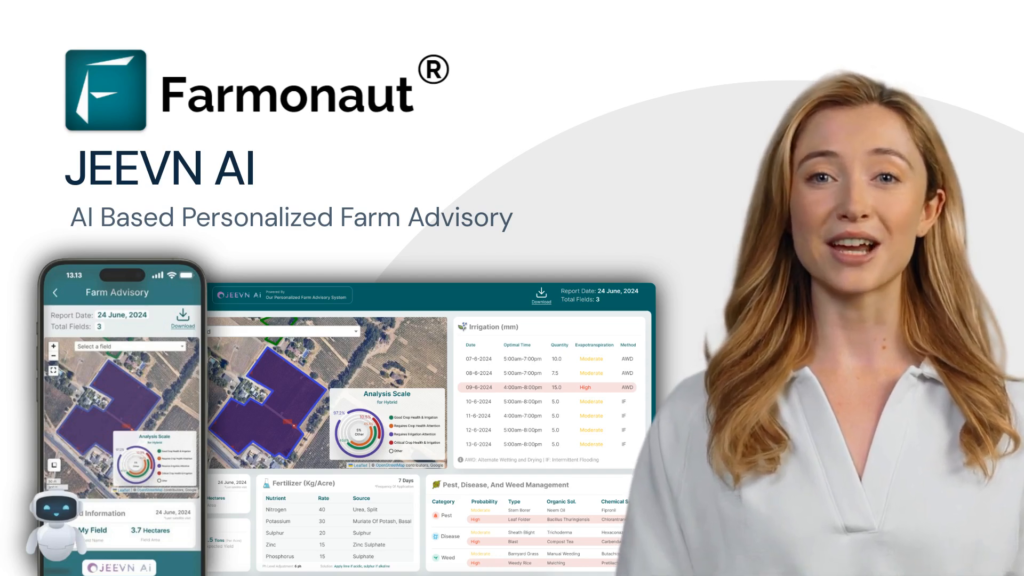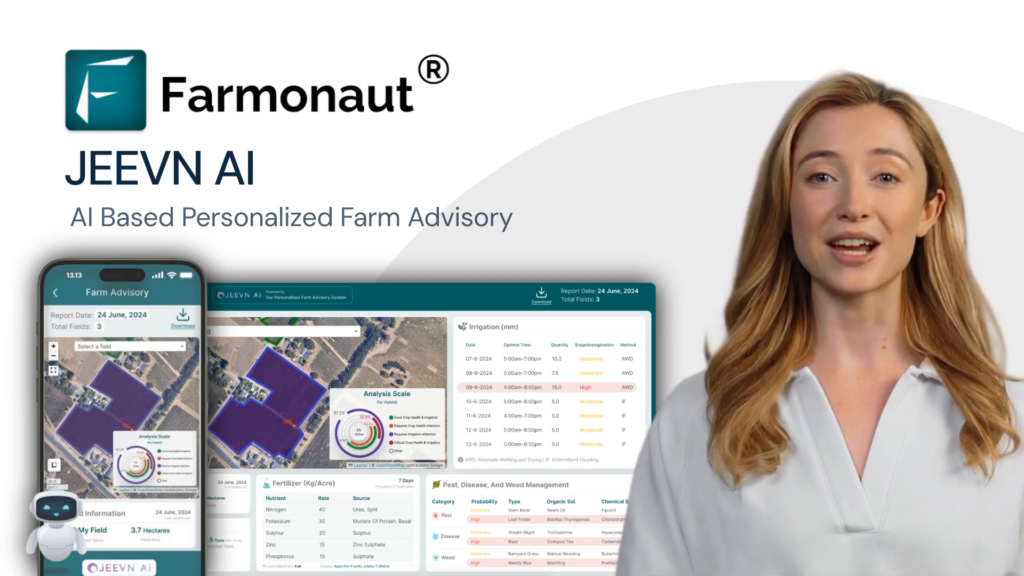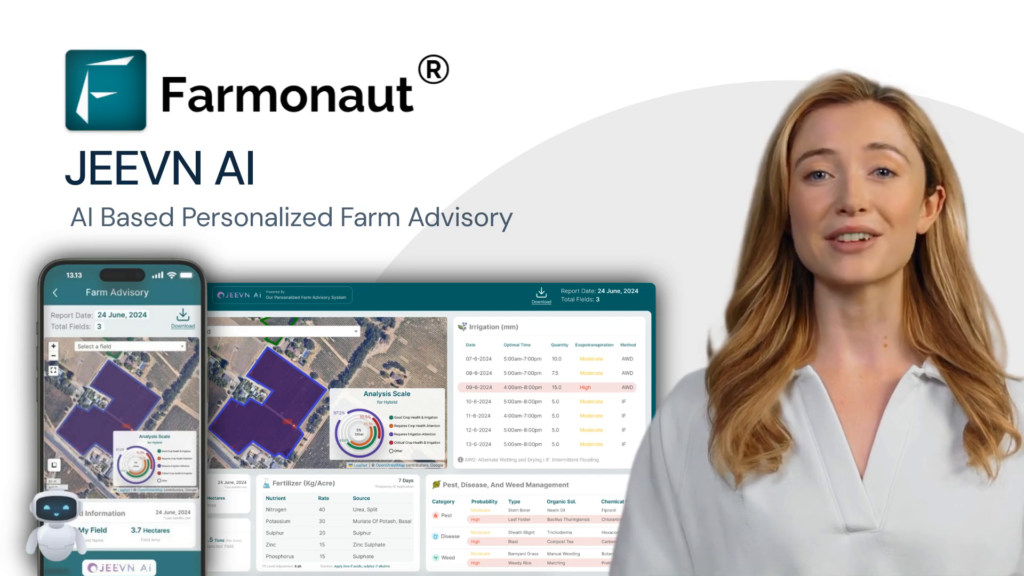California’s Water Crisis: Analyzing Dam Releases and Their Impact on Central Valley Agriculture
“California’s recent dam releases from Terminus and Schafer dams have affected over 1 million acres of Central Valley farmland.”
In the heart of California’s agricultural heartland, a contentious water management decision has sparked intense debate and raised critical questions about the future of farming in the region. As we delve into this complex issue, we at Farmonaut recognize the profound implications for farmers, communities, and the broader agricultural industry. Our mission to make precision agriculture accessible and affordable takes on new significance in light of these challenges.
Understanding the California Water Crisis
California’s water management system has long been a delicate balancing act, juggling the needs of agriculture, urban areas, and environmental conservation. The recent decision to release substantial amounts of water from the Terminus and Schafer dams in the Central Valley has brought this precarious equilibrium into sharp focus.
These dam releases, ostensibly aimed at addressing perceived water crises and mitigating wildfire risks, have instead ignited controversy and concern among farmers, water managers, and environmental experts alike. To fully grasp the implications of this decision, we must first understand the intricate web of California’s water resources and the critical role they play in sustaining one of the world’s most productive agricultural regions.
The Central Valley: California’s Agricultural Powerhouse
The Central Valley, stretching for nearly 450 miles from Redding in the north to Bakersfield in the south, is an agricultural marvel. This vast expanse of fertile land produces more than 250 crops, contributing significantly to California’s $50 billion agricultural industry. The region’s productivity relies heavily on a complex system of water management, including dams, reservoirs, and irrigation networks.

The Terminus Dam on the Kaweah River and the Schafer Dam on the Kings River are critical components of this system, regulating water flow and providing essential irrigation supplies to thousands of farms across the valley. These dams not only serve agricultural needs but also play a crucial role in flood control and hydroelectric power generation.
The Controversy Surrounding Recent Dam Releases
The recent decision to release substantial amounts of water from these dams has raised eyebrows and concerns across the agricultural community. This move, which came at a time when fields are typically dormant and irrigation needs are low, has been criticized for potentially squandering valuable water resources that could be crucial during the peak growing season.
Critics argue that the timing of these releases is particularly problematic, as it fails to align with the agricultural calendar of the Central Valley. Spring and summer, when crops are actively cultivated and water demand is highest, are still months away. This misalignment between water availability and agricultural needs could lead to significant challenges for farmers in the coming growing season.
Impact on Central Valley Agriculture
The repercussions of these dam releases on Central Valley agriculture are multifaceted and potentially far-reaching. Let’s examine the key areas of impact:
1. Water Supply for Irrigation
The immediate effect of the dam releases is a reduction in stored water available for future irrigation. This could lead to:
- Decreased water allocations for farmers during the growing season
- Potential restrictions on certain water-intensive crops
- Increased reliance on groundwater, potentially exacerbating overdraft issues
2. Soil Moisture and Field Preparation
While the releases may temporarily increase soil moisture in some areas, the timing is not optimal for most agricultural operations. This could result in:
- Disrupted field preparation schedules
- Potential delays in planting for early spring crops
- Increased risk of soil erosion in areas receiving excess water
3. Long-term Water Management Strategies
The controversial nature of these releases highlights the need for more coordinated and strategic water management approaches. This situation underscores the importance of:
- Improved communication between water managers and agricultural stakeholders
- Development of more flexible water storage and distribution systems
- Integration of advanced technologies for precise water use monitoring and forecasting
At Farmonaut, we understand the critical role that precise water management plays in sustainable agriculture. Our satellite-based crop health monitoring and AI-driven advisory systems can provide valuable insights to farmers navigating these challenging water conditions.
The Wider Implications of Water Management Decisions
The controversy surrounding these dam releases extends beyond immediate agricultural concerns, touching on broader issues of environmental management, policy-making, and the complex interplay between different regions of California.
Environmental Considerations
While the stated goal of the water releases included potential wildfire mitigation, experts have questioned the effectiveness of this approach. The complex relationship between water management and wildfire prevention in California highlights the need for more nuanced and scientifically-grounded policies.
Additionally, the releases raise questions about:
- Impact on aquatic ecosystems downstream
- Potential effects on endangered species in the affected rivers
- Long-term sustainability of current water management practices
Policy and Governance Challenges
The decision to release water from these dams has exposed some of the fault lines in California’s water governance structure. It highlights:
- The need for better coordination between federal, state, and local water authorities
- The importance of transparent decision-making processes in water management
- The challenge of balancing competing interests in water allocation
“The controversial water management decision in California impacts approximately 25% of the state’s $50 billion agricultural industry.”
Regional Disparities and Water Politics
The situation also underscores the ongoing tensions between different regions of California when it comes to water resources. The misconception that water from Northern California could easily solve Southern California’s wildfire challenges highlights the need for better public understanding of the state’s complex water systems.
These regional dynamics play out in various ways:
- Competition for water resources between urban and rural areas
- Debates over water pricing and allocation mechanisms
- Calls for more equitable distribution of water resources across the state
Technological Solutions for Water Management
In the face of these challenges, advanced technologies offer promising solutions for more efficient and sustainable water management in agriculture. At Farmonaut, we’re at the forefront of developing and implementing these technologies to support farmers and water managers alike.
Satellite-Based Crop Monitoring
Our satellite imagery technology provides real-time insights into crop health and soil moisture levels. This data can help farmers:
- Optimize irrigation schedules
- Identify areas of water stress or excess
- Make informed decisions about water allocation across different fields

AI-Driven Advisory Systems
Our Jeevn AI system analyzes multiple data points to provide personalized recommendations for water management. This includes:
- Customized irrigation advice based on crop type, soil conditions, and weather forecasts
- Predictive modeling for water needs throughout the growing season
- Suggestions for water-conserving practices tailored to specific farm conditions
Blockchain for Water Resource Tracking
While not directly related to farm-level water management, our blockchain technology can contribute to more transparent and efficient water allocation systems at a regional level. This could help:
- Improve accountability in water usage reporting
- Facilitate more equitable water trading mechanisms
- Enhance trust between different stakeholders in the water management ecosystem
The Path Forward: Balancing Agriculture, Environment, and Urban Needs
As we navigate the complexities of California’s water crisis, it’s clear that a multifaceted approach is necessary. This approach must balance the needs of agriculture, environmental conservation, and urban water use while adapting to the realities of climate change and increasing water scarcity.
Sustainable Agricultural Practices
Farmers in the Central Valley are increasingly adopting sustainable practices to maximize water efficiency:
- Drip irrigation systems that reduce water waste
- Crop rotation and diversification to optimize water use
- Cover cropping to improve soil water retention
These practices, combined with technologies like those offered by Farmonaut, can significantly improve water use efficiency in agriculture.
Infrastructure Improvements
Modernizing California’s water infrastructure is crucial for long-term sustainability. This includes:
- Upgrading aging dams and reservoirs
- Implementing more efficient water conveyance systems
- Exploring innovative water storage solutions, such as underground aquifer recharge
Policy and Regulatory Framework
Effective water management requires a supportive policy environment. Key areas for improvement include:
- Developing more flexible water rights systems
- Encouraging water conservation through incentives and pricing mechanisms
- Strengthening collaboration between different levels of government and stakeholders
| Impact Category | Pre-Release Conditions | Post-Release Effects | Estimated Agricultural Impact | Potential Long-term Consequences |
|---|---|---|---|---|
| Available water for irrigation | Adequate reserves for spring/summer | Reduced reserves, potential shortages | ~500,000 acres at risk of under-irrigation | Crop yield reductions, shift to less water-intensive crops |
| Groundwater levels | Already stressed in many areas | Increased reliance, further depletion | Additional 100,000 acre-feet of groundwater extraction | Land subsidence, long-term aquifer damage |
| Soil moisture content | Normal winter levels | Temporary increase, potential waterlogging | 200,000 acres with delayed planting | Soil erosion, nutrient leaching |
| Crop yield projections | Average yields expected | Uncertain, depends on future water availability | 10-15% potential yield reduction across affected areas | Economic losses, market supply disruptions |
| Flood risk assessment | Manageable with existing infrastructure | Increased risk in downstream areas | 50,000 acres at elevated flood risk | Infrastructure damage, crop losses |
| Wildfire prevention effectiveness | Limited direct impact from reservoirs | Negligible improvement in fire risk | No significant impact on agricultural fire risk | Misallocation of water resources away from agriculture |
The Role of Technology in Sustainable Water Management
As we confront the challenges posed by California’s water crisis, technology emerges as a crucial ally in our quest for sustainable solutions. At Farmonaut, we’re committed to leveraging cutting-edge technologies to support farmers and water managers in making informed decisions.
Precision Agriculture and Water Conservation
Our satellite-based crop monitoring system provides farmers with unprecedented insights into their fields’ water needs. By analyzing multispectral imagery, we can:
- Detect early signs of water stress in crops
- Identify areas of overwatering or water waste
- Generate precise irrigation maps for variable rate irrigation systems
This level of precision allows farmers to apply water exactly where and when it’s needed, significantly reducing overall water consumption while maintaining or even improving crop yields.
AI-Powered Predictive Analytics
Our Jeevn AI system goes beyond current conditions, offering predictive insights that help farmers and water managers plan for the future. This includes:
- Long-term weather forecasting integrated with crop water needs
- Predictive modeling of reservoir levels and water availability
- Scenario planning for different water allocation strategies
By leveraging these predictive capabilities, stakeholders can make more informed decisions about water use and allocation, potentially avoiding crises like the recent controversial dam releases.
Blockchain for Transparent Water Management
While our blockchain technology is primarily used for supply chain traceability, its potential applications in water management are significant. By creating an immutable record of water transactions and usage, we can:
- Enhance transparency in water rights and allocations
- Facilitate more efficient water markets and trading
- Improve accountability in water use reporting
This level of transparency and accountability could be crucial in building trust among different stakeholders and ensuring more equitable water distribution.
Collaborative Approaches to Water Management
As we’ve seen from the controversy surrounding the recent dam releases, effective water management requires collaboration and communication among various stakeholders. At Farmonaut, we believe that technology can play a crucial role in facilitating this collaboration.
Data Sharing and Integration
Our platform allows for the integration of various data sources, including:
- Satellite imagery and weather data
- On-ground sensor networks
- Historical crop and water use data
By combining these diverse data streams, we can create a more comprehensive picture of water resources and needs across the Central Valley. This integrated approach can inform more holistic water management strategies that consider the needs of all stakeholders.
Community-Based Water Management
We’re exploring ways to use our technology to support community-based water management initiatives. This could involve:
- Creating shared dashboards for water use and availability within irrigation districts
- Facilitating peer-to-peer learning about water conservation techniques
- Supporting the development of local water management plans
By empowering local communities with data and tools, we can foster more sustainable and equitable water management practices from the ground up.
Looking to the Future: Adapting to Climate Change
The recent water management controversies in California are a stark reminder of the challenges posed by climate change. As we look to the future, it’s clear that adapting to these changes will require innovative approaches and technologies.
Climate-Resilient Agriculture
Our technology at Farmonaut is helping farmers adapt to changing climate conditions by:
- Providing early warnings of extreme weather events
- Recommending drought-resistant crop varieties based on local conditions
- Optimizing planting and harvesting schedules to maximize water efficiency
Water Resource Planning
Looking beyond individual farms, our data and analytics can support broader water resource planning efforts:
- Modeling long-term climate scenarios and their impact on water availability
- Identifying areas at risk of water scarcity or flooding
- Supporting the development of climate-adaptive water infrastructure
Conclusion: A Path Forward for California’s Water Future
The recent controversy surrounding dam releases in California’s Central Valley has brought to light the complex challenges facing the state’s water management system. As we’ve explored in this article, addressing these challenges requires a multifaceted approach that balances the needs of agriculture, urban areas, and the environment.
At Farmonaut, we’re committed to being part of the solution. Our advanced satellite technology, AI-driven analytics, and blockchain capabilities offer powerful tools for more efficient and sustainable water management. By providing farmers and water managers with precise, real-time data and predictive insights, we’re helping to optimize water use and support more informed decision-making.
However, technology alone is not enough. Addressing California’s water crisis will require collaboration among all stakeholders, innovative policy solutions, and a commitment to long-term sustainability. As we face the challenges of climate change and increasing water scarcity, the lessons learned from the Central Valley can inform water management strategies not just in California, but around the world.
We invite farmers, water managers, policymakers, and all those interested in sustainable agriculture to explore how Farmonaut’s solutions can support their water management efforts. Together, we can work towards a more water-secure future for California and beyond.
FAQ Section
Q1: How does Farmonaut’s technology help in water management?
A1: Farmonaut uses satellite imagery and AI to provide real-time crop health monitoring and soil moisture analysis. This helps farmers optimize irrigation, reduce water waste, and make data-driven decisions about water use.
Q2: Can Farmonaut’s solutions be applied to large-scale water management projects?
A2: Yes, our technology can be scaled to support regional water management efforts. Our data and analytics can inform policy decisions, support water allocation strategies, and help in long-term water resource planning.
Q3: How does blockchain technology contribute to water management?
A3: While primarily used for supply chain traceability, our blockchain technology can potentially enhance transparency in water rights and usage reporting, facilitating more efficient water markets and improving accountability.
Q4: Is Farmonaut’s technology accessible to small-scale farmers?
A4: Absolutely. We’ve designed our solutions to be affordable and accessible to farmers of all scales. Our mobile app and web platform make it easy for even small-scale farmers to access advanced agricultural insights.
Q5: How can Farmonaut’s technology help in adapting to climate change?
A5: Our predictive analytics and AI-driven advisory system help farmers adapt to changing climate conditions by providing early warnings of extreme weather events, recommending drought-resistant crops, and optimizing farm management practices for water efficiency.
For more information on how Farmonaut can support your agricultural and water management needs, please explore our web app, Android app, or iOS app. Developers interested in integrating our technology can check out our API and API Developer Docs.













